
Euphorbias, spurge: planting, growing and care
Contents
Euphorbias in a nutshell
- Euphorbias offer true diversity, both in terms of shapes and colours
- Their flowers in green-yellow hues add a colourful touch to the garden
- They are very structural plants that have a beautiful presence in rockeries or wild-inspired beds
- Their foliage can take on stunning shades in autumn!
- They are robust plants, low-maintenance, easy to grow, and content with little
A word from our Expert
Euphorbias are perennial, annual, or biennial plants that have a beautiful silhouette and often offer colourful foliage. Their flowers are green-yellow and very bright. The most popular is undoubtedly the Mediterranean spurge, or Euphorbia characias, which forms a small graphic bush with glaucous foliage. However, many other species, such as Martin’s spurge, Euphorbia martinii, and Corsican spurge, Euphorbia myrsinites, deserve a place in our gardens!
Euphorbias are so different from one species to another that one might find it hard to believe they belong to the same group: between the small herbaceous euphorbias, the large arborescent species, and the succulent ones resembling cacti, the differences are striking!
Most euphorbias thrive in full sun and well-drained soil, but there are also exceptions, and some species grow well in shaded conditions. Euphorbias will easily integrate into a flowerbed or mixed border, in a naturalistic garden, or in a Mediterranean rockery. Some euphorbias are more suited for indoor cultivation, but these are mainly the succulent species (resembling cacti). It is possible to propagate euphorbias by sowing, propagation by cuttings, or division. Maintenance is quite minimal, but some species, such as Euphorbia characias, will appreciate pruning after flowering.
Botany
Botanical data
- Latin name Euphorbia sp.
- Family Euphorbiaceae
- Common name Spurge
- Flowering spring or summer
- Height between 20 cm and 1.20 m
- Exposure sun or partial shade
- Soil type ordinary, draining, poor, even rocky
- Hardiness very variable, but most garden euphorbias (presented here) are quite hardy.
With over 2,000 species, euphorbias form an enormous and extremely varied group. They have a wide global distribution, being found in both temperate and tropical regions. They grow in Africa, Asia, Europe, and the Americas. Many species can be found in France. The small Euphorbia peplus is common in gardens, cities, and on pavements… One can also easily encounter Euphorbia helioscopia, Euphorbia amygdaloides, or Euphorbia cyparissias in the wild.
Most cultivated euphorbias are perennials, but there are also annuals (like Euphorbia marginata) and biennials (Euphorbia lathyris). Some euphorbias are grown as houseplants (notably succulent species…).
Euphorbias were named in honour of Euphorbus, physician to King Juba II of Mauretania (1st century BC). He is said to have discovered the toxic and medicinal properties contained in the latex of these plants.
Euphorbias are truly unique plants, with their own characteristics. They have given their name to the family Euphorbiaceae, which includes acalyphas, crotons (Codiaeum variegatum), castor oil plants, and mercurials… as well as some utilitarian plants, such as Manihot esculenta, which produces cassava, and Hevea, a tree whose latex is used to produce rubber. Euphorbiaceae are mainly found in tropical and subtropical regions.
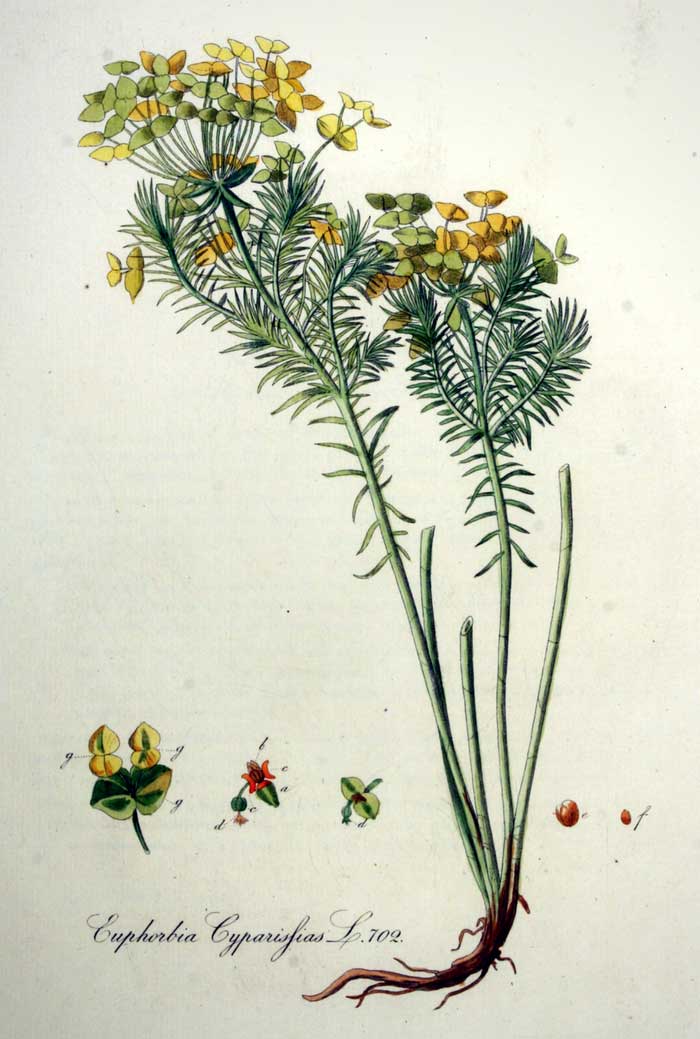
Euphorbia cyparissias: botanical illustration
Euphorbias are truly polymorphous plants: they take on very diverse forms. Some are small herbaceous plants with a thin habit, while others are arborescent, reaching up to 20 m in height, and some resemble cacti… What unites them is their sap, the white latex that flows from their tissues. This is almost their only common point.
Euphorbias therefore take on extremely varied forms. Regarding species commonly cultivated in gardens, Euphorbia characias have a shrubby habit and sometimes exceed 1 m in height. Others, like Euphorbia myrsinites, have a creeping, prostrate habit. Some can thus be used as ground cover. Many euphorbias, like Euphorbia polychroma, form beautiful well-rounded clumps. It is common for euphorbias to have a silhouette that is wider than tall. They often have a rather voluminous and dense appearance. Euphorbias cultivated in gardens typically measure between 20 cm and 1.20 m in height.
Some euphorbias stand out for their originality. For instance, the crown of thorns (Euphorbia milii) is distinguished by its spiny branches and beautiful bright red flowers. The very colourful Euphorbia pulcherrima (Poinsettia, or Christmas Star) is notable for its decorative red bracts.
Among the succulents, one can mention the large Euphorbia canariensis and Euphorbia candelabrum, which resemble cacti, as well as Euphorbia ferox, which can also be mistaken for a small cactus, or Euphorbia obesa, which has a very cylindrical, globular shape.
Euphorbias contain a white latex in their tissues, which flows when a stem or leaf is broken. It is very irritating to the skin and toxic if ingested. One should avoid rubbing the eyes after handling the plant.
Depending on the varieties, euphorbias flower in spring or summer. The earliest bloom from March-April, while the later flowering species finish in August-September. Euphorbia pulcherrima, also known as Poinsettia, is unique in that it flowers in mid-winter, earning it the name Christmas Star.
Euphorbias have very particular inflorescences, quite strange, called cyathes. They are gathered in cymes, resembling somewhat to umbels, and are generally borne at the tips of the upright stems. Each inflorescence (cyath) consists of a central female flower with a style, and male flowers, each with a stamen. All of this is surrounded by large bracts, which take the form of a cup. The flowers are extremely reduced, lacking sepals and petals. The inflorescence also typically contains four to five nectar glands, often crescent-shaped.
The inflorescences of euphorbias generally have beautiful bright, fresh colours, in vivid yellow or green tones. Euphorbia griffithii (notably the variety ‘Fireglow’) boasts a striking orange-red bloom.
In Euphorbia pulcherrima, it is not the flowers that are decorative, but the large red bracts surrounding them. In other species, such as Euphorbia corollata or Euphorbia fulgens, the bracts surrounding the flower have transformed to take the shape of petals. Thus, the flowers give the impression of having five ordinary petals. The species Euphorbia hypericifolia also stands out for its very different appearance from other euphorbias! It bears countless small white flowers, giving the plant a airy and light style. Here too, it is the bracts that are decorative.

The original flowering of euphorbias! Euphorbia pekinensis (photo Dalgial), Euphorbia characias (photo Joan Simon), and Euphorbia corollota (photo Joshua Mayer). The flowers of Euphorbia corollata seem ordinary, but the “petals” are actually modified bracts, as euphorbias do not possess petals or sepals.
The leaves of euphorbias are simple, undivided, with a lamina that has an entire margin. They generally have an elongated shape (ovate to linear), but their size is extremely variable. They can be thin or fleshy, thick, and are often alternate.
Euphorbias can be deciduous or evergreen. Some species lose their leaves in winter while others retain them all year round.
The euphorbia lathyris has long, thin leaves arranged in a cross, very regularly. The Euphorbia myrsinites is appreciated for its beautiful, pointed, blue-green leaves, arranged in a spiral around the stem. The euphorbia pythiusa has very small, fine leaves arranged all around the stem, somewhat reminiscent of fir foliage. Some euphorbias (notably succulent forms) have the characteristic of bearing thorns instead of leaves, like cacti.
Some euphorbias are truly interesting for the colours of their foliage! There are variegated varieties, such as ‘Tasmanian Tiger’. Euphorbia ‘Ascot Rainbow’ is very colourful: the young leaves are red, and then turn green, edged in yellow. The leaves can also be dark purple, as seen in Euphorbia amygdaloides ‘Purpurea’, which beautifully highlights the flowering. More surprisingly, Euphorbia dulcis ‘Chameleon’ has a hue that changes throughout the year, becoming purple in autumn. We also appreciate Euphorbia griffithii for its foliage that becomes vibrant in autumn.

The foliage of euphorbias takes on various shapes and colours. Euphorbia lathyris (photo J.H. Mora), Euphorbia amygdaloides ‘Ascot Rainbow’, Euphorbia myrsinites and Euphorbia ‘Black Bird’
Some euphorbias spread widely thanks to their creeping rhizomes. This is the case, for example, with Euphorbia amygdaloides ‘Robbiae’, which can form beautiful colonies, or Euphorbia cyparissias. It may be necessary to stop the expansion of these euphorbias.
The fruit of the euphorbia is a rounded capsule, attached to a peduncle. When ripe, the capsule explodes, opening in three parts, and then expels the seeds around the plant. It is quite common for ants to disperse the seeds, thanks to the presence of elaiosomes (a growth attached to the seeds that is appreciated by ants).

The fruits (capsules) of Euphorbia dendroides (photo Gideon Pisanty), and the fruits and seeds of Euphorbia paralias (photo Roger Culos – Museum de Toulouse)
Most garden euphorbias are quite hardy. Others, like succulent euphorbias, can be grown indoors or in a greenhouse.
The main varieties of euphorbias
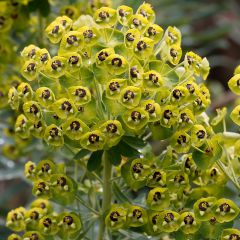
Euphorbia characias - Spurge
- Flowering time July to October
- Height at maturity 80 cm
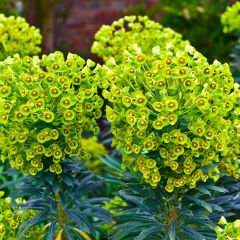
Euphorbia characias subsp. wulfenii - Spurge
- Flowering time April to July
- Height at maturity 90 cm

Euphorbia characias Tasmanian Tiger - Spurge
- Flowering time May, June
- Height at maturity 80 cm
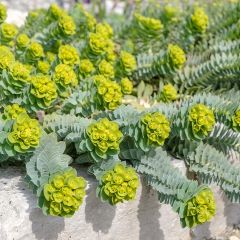
Euphorbia myrsinites - Spurge
- Flowering time April to June
- Height at maturity 10 cm
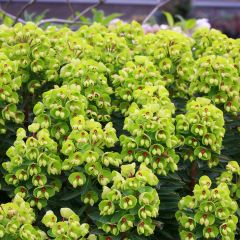
Euphorbia martinii Baby Charm - Spurge
- Flowering time May to July
- Height at maturity 30 cm
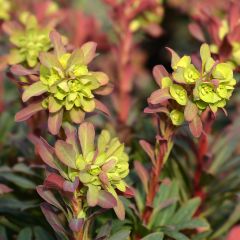
Euphorbia amygdaloides Purpurea - Spurge
- Flowering time May to July
- Height at maturity 55 cm
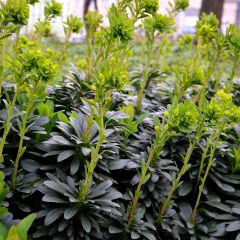
Euphorbia amygdaloïdes var. robbiae - Spurge
- Flowering time May, June
- Height at maturity 50 cm
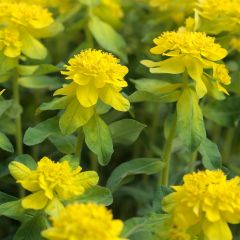
Euphorbia polychroma - Spurge
- Flowering time May, June
- Height at maturity 40 cm

Euphorbia dulcis Chameleon - Spurge
- Flowering time June to August
- Height at maturity 40 cm
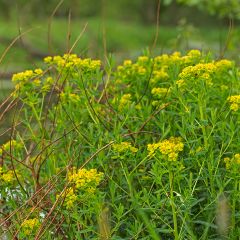
Euphorbia palustris - Spurge
- Flowering time May to July
- Height at maturity 1,50 m
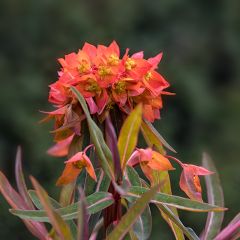
Euphorbia griffithii Fireglow - Spurge
- Flowering time June, July
- Height at maturity 60 cm

Euphorbia martinii Ascot Rainbow - Spurge
- Flowering time May to July
- Height at maturity 60 cm

Euphorbia lathyris - Spurge
- Flowering time August, September
- Height at maturity 90 cm
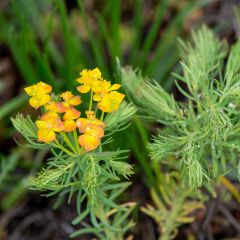
Euphorbia cyparissias - Spurge
- Flowering time May to August
- Height at maturity 30 cm
Discover other Euphorbia - Spurge
View all →Available in 1 sizes
Available in 4 sizes
Available in 1 sizes
Available in 1 sizes
Available in 1 sizes
Available in 1 sizes
Available in 1 sizes
Available in 1 sizes
Available in 1 sizes
Available in 1 sizes
Planting euphorbias
Where to plant?
Most euphorbias thrive in full sun. Those with purple or reddish foliage take on more beautiful hues when exposed to direct sunlight. However, some species, such as Euphorbia amygdaloides or Euphorbia dulcis, are suited for planting in woodland areas, in shade or partial shade.
Euphorbias grow well in fairly ordinary soil. They do not like stagnant moisture and therefore prefer well-drained sites. Feel free to add gravel or coarse sand to facilitate water infiltration. However, Euphorbia palustris enjoys moist soils.
Euphorbias are quite content with poor soil. On the contrary, for most species, it is better to avoid soils rich in organic matter, with the exception of Euphorbia griffithii and Euphorbia polychroma, which prefer substrates rich in humus.
Some euphorbias adapt very well to pot cultivation, for example, to enhance a terrace or an indoor courtyard.
For rock garden cultivation, Euphorbia myrsinites is particularly suitable. For woodland areas, opt for Euphorbia amygdaloides, the wood euphorbia. Euphorbia palustris prefers cool, even moist, soils.
Reflecting their true diversity, euphorbias have different requirements depending on the species. Some prefer partial shade, others slightly cooler soils, and some are better suited for indoor cultivation… They generally appreciate well-drained, poor, and sunny sites, but there are often exceptions! It is best to choose their location carefully, as once established, euphorbias do not like to be moved.
When to plant?
Euphorbias are planted in autumn. This allows them to start settling in before winter and to flourish in spring. It is also possible to plant them in spring, starting from April. In any case, intervene outside of frost periods.
How to plant?
In the ground:
- Dig a planting hole two to three times the size of the root ball. Add some coarse sand or gravel if necessary to improve drainage.
- Remove the root ball from its pot and place it in the planting hole.
- Replace the soil all around.
- Gently firm it down with the palm of your hand.
- Water generously.
In a pot:
- Choose a large pot, preferably made of terracotta.
- Place a layer of gravel, broken pot shards, or clay balls at the bottom to allow water to drain more easily.
- Add a well-draining substrate (for example, potting soil and coarse sand) to the pot.
- Place your euphorbia in the pot.
- Replace the substrate all around.
- Water.
→ Learn more about growing euphorbia in pots
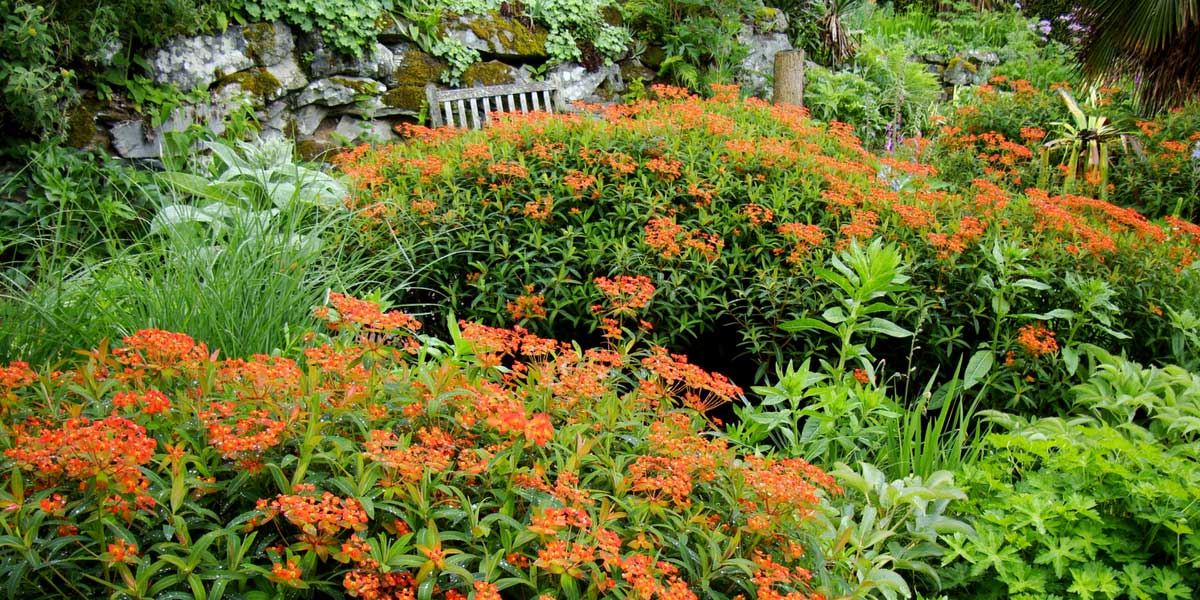
Euphorbia griffithii ‘Dixter’ (photo Christopher)
Maintenance
Most euphorbias are relatively drought-resistant and are satisfied with infrequent watering. They fear excess moisture in winter. Just water during prolonged dry spells. However, the needs differ from one species to another. For example, euphorbias with light, fine foliage will require a bit more water than those with fleshy leaves, or than succulent species, the latter behaving like cacti by storing water in their tissues.
Euphorbias do not need fertiliser, as the majority of them grow quite well in poor soils. It is therefore also unnecessary to add compost, except for a few species like Euphorbia griffithii or Euphorbia polychroma, which thrive in humus-rich soils.
Some species with a running habit, such as Euphorbia amygdaloides ‘Robbiae’, may sometimes need to be contained to limit their spread. Similarly, if your euphorbias tend to self-seed, you can cut off the faded flowers to prevent the appearance of seeds.
Most garden euphorbias are relatively hardy and therefore do not need winter protection. If you are growing other species, particularly succulent euphorbias, you can bring them indoors for the winter to protect them from the cold.
You can weed and remove the spontaneous seedlings that appear at the base of your euphorbias. We also recommend installing a layer of mulch to limit weeding.
If you are growing them in pots, remember to repot your euphorbias from time to time (every one to two years), in spring.
Pruning:
For some euphorbias, such as Euphorbia characias, it is best to carry out pruning once flowering is finished. Cut back the stems that have flowered close to ground level.
For deciduous species like Euphorbia griffithii, you can tidy up the clumps at the end of winter to remove dead or dried parts.
Beware of latex: euphorbias contain a toxic, milky sap in their tissues that can irritate the skin. We recommend wearing gloves and not rubbing your eyes after handling the plant.
Diseases and Pests
Euphorbias can be affected by Botrytis. Also known as grey mould, this disease is caused by a fungus and typically appears due to excess moisture, often from overly heavy soil. A confined environment also promotes this disease. Similarly, in a substrate that is not well-draining, it is possible for the roots of the euphorbia to rot. Euphorbias, particularly Euphorbia cyparissias, can also be affected by rust. This fungal disease is identified by the appearance of rust-coloured spots on the foliage. You can treat it using a horsetail decoction.
Regarding pests and parasites, euphorbias can be attacked by aphids. They pierce the tissues and extract the sap from the plant, weakening it in the process. To get rid of them, we recommend spraying black soap on the foliage. Euphorbias grown indoors can sometimes be affected by whiteflies, or aleurodes. Finally, you may also notice mealybugs appearing on your plants, although this mainly concerns succulent euphorbias.
Multiplication
Sowing
Euphorbias (notably Euphorbia characias) tend to self-seed spontaneously. Annual species can be sown directly in situ, in open ground, while perennials are better sown in trays, under a frame. Sowing takes place in spring and is quite easy to achieve.
- Take a tray or container and fill it with a light, poor potting mix, without fertiliser.
- Water to ensure the substrate is well moist.
- Sow the seeds by spreading them over the surface.
- Cover them with a layer of sieved potting mix (no more than twice the size of the seeds).
- Lightly press down.
- Water gently.
- Place your sowing under a cold frame, in a bright location but out of direct sunlight. The temperature should be between 18 and 22 °C.
The substrate should remain slightly moist until germination. You may optionally cover the tray with plastic film to prevent it from drying out.
Propagation by Cuttings
You can propagate euphorbias in spring, around April-May, or in late summer for Euphorbia characias (after flowering). Since euphorbias are very diverse, the following example is mainly suitable for Euphorbia characias and closely related species.
- Prepare a pot, filling it with a draining substrate (a mix of potting soil and coarse sand).
- Take a young shoot, preferably from the base of the plant. The stem should measure between 7 and 10 centimetres in length.
- Place it in warm water to stop the flow of sap.
- Remove the leaves at the base of the stem, leaving only those at the top.
- Plant the stem in the substrate.
- Place the pot in a bright location, out of direct sunlight, and keep the substrate slightly moist until the cutting begins to grow.
Division of Clumps
Perennial euphorbias can be multiplied by division. This operation can be carried out in autumn or late winter (March), for species such as Euphorbia characias or Euphorbia griffithii.
Start by digging up the stump using a fork. Separate the clumps by taking young shoots that have a few roots each time. Replant them in a new location, then water.
→ Learn more about the multiplication of euphorbias in our tutorial!
Association
Euphorbias can be integrated into a border with other perennials. Plant them alongside columbines, lady’s mantle, hardy geraniums, or polemoniums, and in the company of small bushes. We recommend favouring vibrant flowerings!
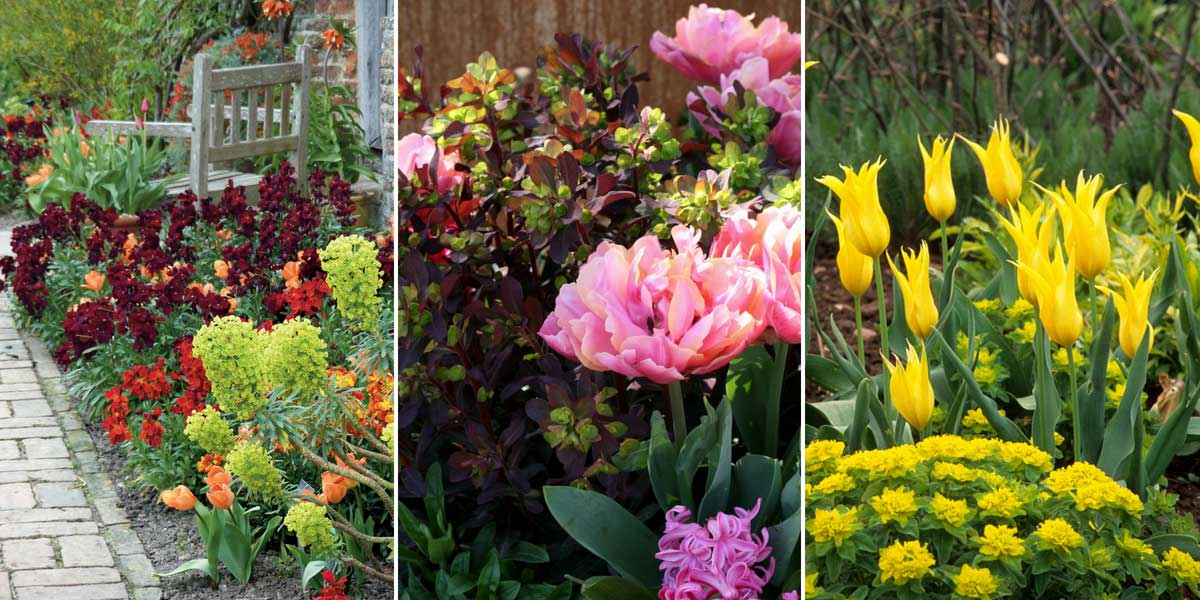
Some examples of associations with euphorbias! Euphorbia characias ssp. wulfenii, Erysimum ‘Bedder Scarlet’, Erysimum ‘Bedder Vulcan Brune’ / Euphorbia ‘Black Bird’ and double tulip ‘Britt’ / Euphorbia polychroma and tulip ‘West Point’ (photo Andrew Lawson – Garden Collection – Biosphoto)
Euphorbias are ideal for integrating into a Mediterranean-style garden! Choose species such as Euphorbia characias or Euphorbia myrsinites. You can pair them with succulents and aromatic plants. For example, plant them with thyme, lavender, phlox, Jerusalem sage, sedums… Create a Mediterranean rockery, a dry garden with a mineral focus, which will require very little maintenance!
You can also create a composition by placing euphorbias in a large terracotta pot, alongside succulents, cacti, sedums, or houseleeks…
Euphorbias with a wild appearance, such as Euphorbia amygdaloides or Euphorbia palustris, are perfect for integrating into a naturalistic border! Combine them with grasses, loosestrifes, flax, bellflowers, or burnets… Always in a very natural style, some euphorbias can also be integrated into a woodland garden. This is the case with Euphorbia polychroma, which is ideal for brightening up a shady corner. Plant it alongside ferns, hostas, brunneras, Solomon’s seals… Also enjoy the stunning blue flowers of bluebells (Hyacinthoides non-scripta)!
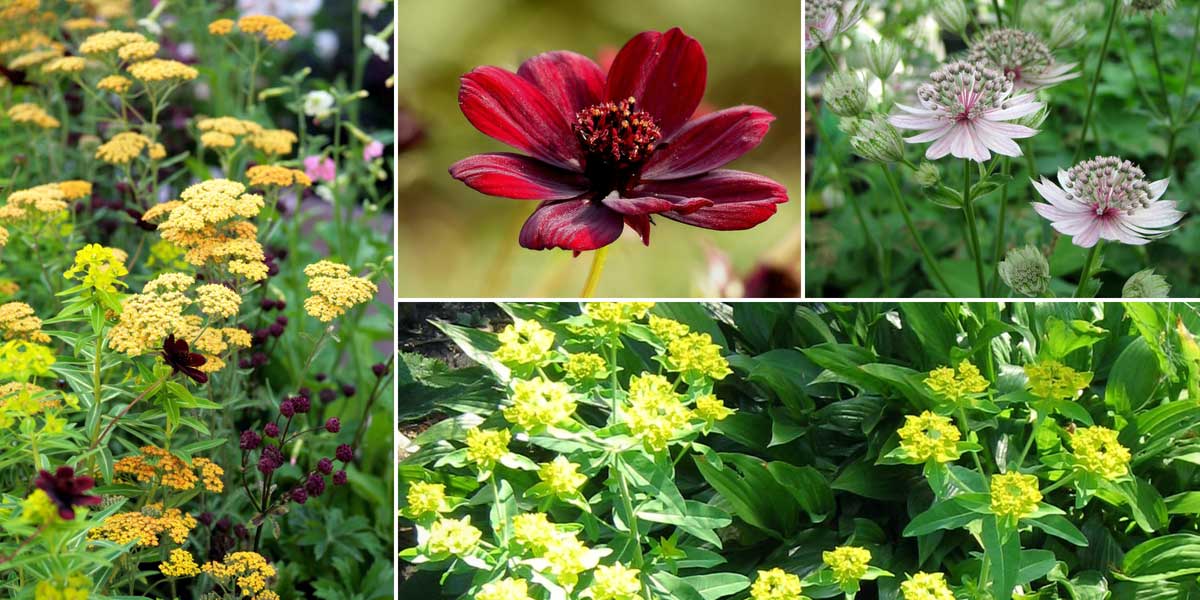
Euphorbias can be integrated into a naturalistic garden. An example of an association with Euphorbia schillingii, Achillea ‘Terracotta’, Cosmos atrosanguineus, and astrantias. / Cosmos atrosanguineus / Astrantia major ‘Rosea’ / Euphorbia schillingii
You can also choose to play with colours, for example by favouring shades that contrast with the green-yellow of euphorbias. Or by integrating plants with colourful foliage that complement the hues of the euphorbias… Don’t hesitate to take advantage of the wide range of colours offered by heucheras!
Euphorbias can also find their place in an exotic border. This is particularly true for Euphorbia characias, or Euphorbia griffithii, with their vibrant hues. They pair well with castor oil plants, phormiums, cordylines, agaves, or colocasias… Prefer exuberant foliage and warm-toned flowerings.
Did you know?
- A spurge to drive away moles?
Euphorbia lathyris, or Gopher Spurge, is reputed to repel moles. However, it does not scare them away when simply planted: to be effective, branches must be cut and inserted into the tunnels. The latex contained in the stems will irritate the moles’ snouts.
- Spurge or cactus?
Some spurges have had to adapt to the sun and drought by developing the same evolutionary strategies as cacti. Their tissues have swollen, and the stems have become succulent, allowing them to store water. Leaves have been replaced by thorns. This phenomenon is called form convergence. Cacti can be identified by the presence of areoles (small rounded growths) at the base of the thorns, while spurges do not have them. Spurges have a white latex that appears at the slightest wound, whereas cacti have a more transparent sap.
Useful resources
-
- Discover our wide range of spurges!
- Our advice sheet: 4 repellent plants to keep moles away
- Our advice sheet: 7 variegated spurges
- Our advice sheet: 7 spurges for border planting
- The website of the International Euphorbia Society, with plenty of information on spurges and their cultivation
- To discover: green flowers!
- Our advice sheet: Growing a spurge in a pot
- Discover spurges for dry soil
- Discover green-flowered perennials, gems of the plant world!
Frequently asked questions
-
The foliage of my euphorbia has orange spots! What should I do?
It is likely affected by rust, a fungal disease that affects some species such as Euphorbia cyparissias or Euphorbia griffithii. Reduce watering, as this disease is encouraged by moisture, and treat if necessary with horsetail manure or a sulphur-based solution.
- Subscribe!
- Contents
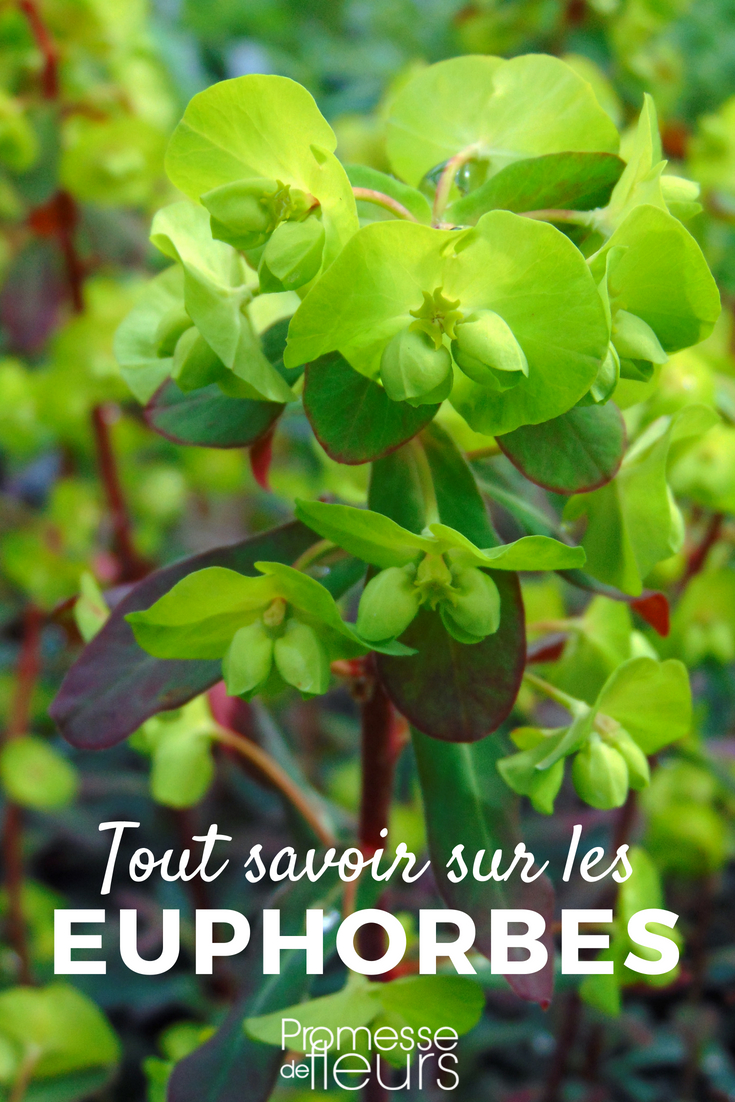
































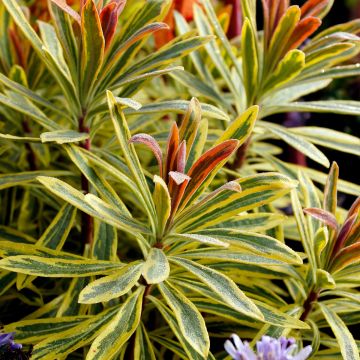
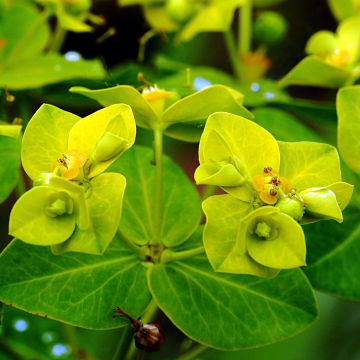


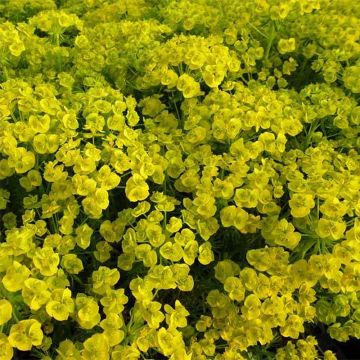
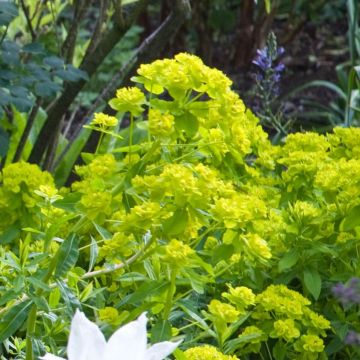


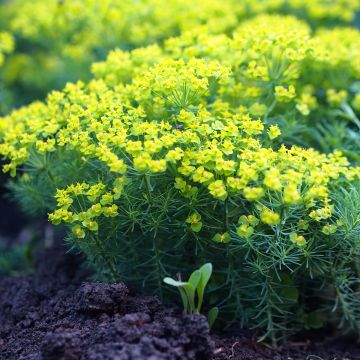
Comments